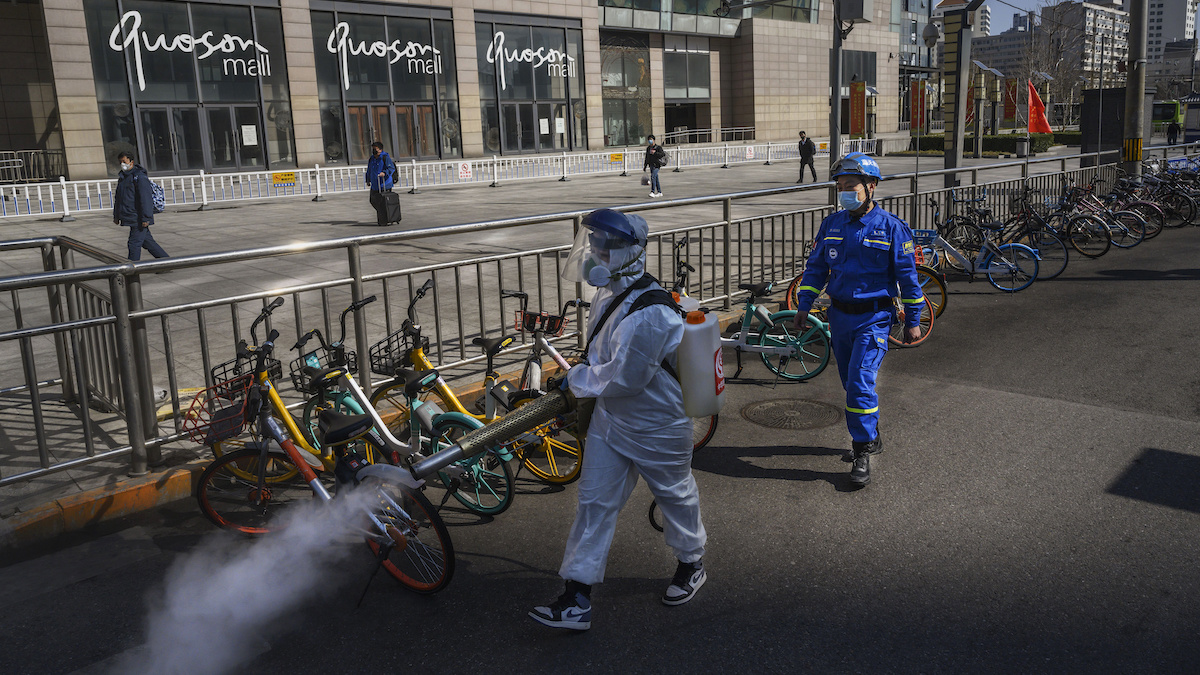
What’s the Difference Between Pandemic, Epidemic and Outbreak?

A volunteer from Blue Sky Rescue wears a protective suit as she fumigates and disinfects outside an area of a local bus station on March 7, 2020 in Beijing, China. Kevin Frayer / Getty Images
By Rebecca S.B. Fischer
The coronavirus is on everyone’s minds. As an epidemiologist, I find it interesting to hear people using technical terms – like quarantine or super spreader or reproductive number – that my colleagues and I use in our work every day.
But I’m also hearing newscasters and neighbors alike mixing up three important words: outbreak, epidemic and pandemic.
Simply put, the difference between these three scenarios of disease spread is a matter of scale.
Outbreak
Small, but unusual.
By tracking diseases over time and geography, epidemiologists learn to predict how many cases of an illness should normally happen within a defined period of time, place and population. An outbreak is a noticeable, often small, increase over the expected number of cases.
Imagine an unusual spike in the number of children with diarrhea at a daycare. One or two sick kids might be normal in a typical week, but if 15 children in a daycare come down with diarrhea all at once, that is an outbreak.
When a new disease emerges, outbreaks are more noticeable since the anticipated number of illnesses caused by that disease was zero. An example is the cluster of pneumonia cases that sprung up unexpectedly among market-goers in Wuhan, China. Public health officials now know the spike in pneumonia cases there constituted an outbreak of a new type of coronavirus, now named SARS-CoV-2.
As soon as local health authorities detect an outbreak, they start an investigation to determine exactly who is affected and how many have the disease. They use that information to figure out how best to contain the outbreak and prevent additional illness.
Epidemic
Bigger and spreading.
An epidemic is an outbreak over a larger geographic area. When people in places outside of Wuhan began testing positive for infection with SARS-CoV-2 (which causes the disease known as COVID-19), epidemiologists knew the outbreak was spreading, a likely sign that containment efforts were insufficient or came too late. This was not unexpected, given that no treatment or vaccine is yet available. But widespread cases of COVID-19 across China meant that the Wuhan outbreak had grown to an epidemic.
Pandemic
International and out of control.
In the most classical sense, once an epidemic spreads to multiple countries or regions of the world, it is considered a pandemic. However, some epidemiologists classify a situation as a pandemic only once the disease is sustained in some of the newly affected regions through local transmission.
To illustrate, a sick traveler with COVID-19 who returns to the U.S. from China doesn’t make a pandemic, but once they infect a few family members or friends, there’s some debate. If new local outbreaks ensue, epidemiologists will agree that efforts to control global spread have failed and refer to the emerging situation as a pandemic.
Terms Are Political, Not Just Medical
Epidemiologists are principally concerned with preventing disease, which may be fundamentally different than the broader concerns of governments or international health organizations.
As of this writing, the World Health Organization classifies the risk of global COVID-19 spread as “very high,” the highest level in their risk classification scheme and one step below an official pandemic declaration. This means that the WHO remains hopeful that, by taking aggressive steps now, containment of localized outbreaks may still be possible.
But I and other scientists and public health officials are already calling this a pandemic. The official numbers count an excess of 100,000 cases in almost 100 countries, and community spread has been documented in the U.S. and elsewhere. By the classical definition, it’s a pandemic.
A formal declaration of COVID-19 or any other infectious disease as pandemic tells governments, agencies and aid organizations worldwide to shift efforts from containment to mitigation. It has economic, political and societal impacts on a global scale.
Formal declaration needn’t incite fear or cause you to stockpile surgical masks. It doesn’t mean the virus has become more infectious or more deadly, nor that your personal risk of getting the disease is greater. But it will be a historical event.
Reposted with permission from The Conversation.
- WHO Elevates Coronavirus Threat to Highest Level - EcoWatch
- Coronavirus Spreading in U.S. Could Cause 'Severe' Disruption to ...
- Nobel Prize for Medicine Goes to Trio Behind Hepatitis C Discovery - EcoWatch
- Healing Relationship With Nature Key to Stopping Next Pandemic

 233k
233k  41k
41k  Subscribe
Subscribe 